
For the longest time, I assumed that eggs were a must-have in cheesecake. In light of egg shortages in Australia, though, a quick search told me that this was not the case. Naturally, I had to test the theory and here we are with this eggless cheesecake recipe!
Eggless cheesecake (gluten free)
This cheesecake uses cream cheese (which can be lactose free) and full fat sour cream or double cream as the dairy components. The binding capacity of the eggs is replaced with a small amount of cornstarch. Caster sugar/superfine sugar sweetens the cheesecake and it is flavoured with vanilla bean extract and some optional lemon juice.
The gluten free cheesecake base is entirely homemade – no expensive store bought biscuits required. It uses half toasted quinoa flour (which you can grind yourself – more on this later) and white rice flour. It has an option to add xanthan gum and although it is not required, it’s worth noting that cream cheese already contains xanthan gum.
Creamed butter and sugar along with a small amount of optional baking powder give the cheesecake base an airy texture. It is baked prior to adding the cream cheese filling for a crisp and snappy base along with a delightfully creamy cheesecake top.
All in all, the recipe is gluten free, egg free, nut free and can be made low lactose and thus low FODMAP. A delicious alternative to an egg based cheesecake.
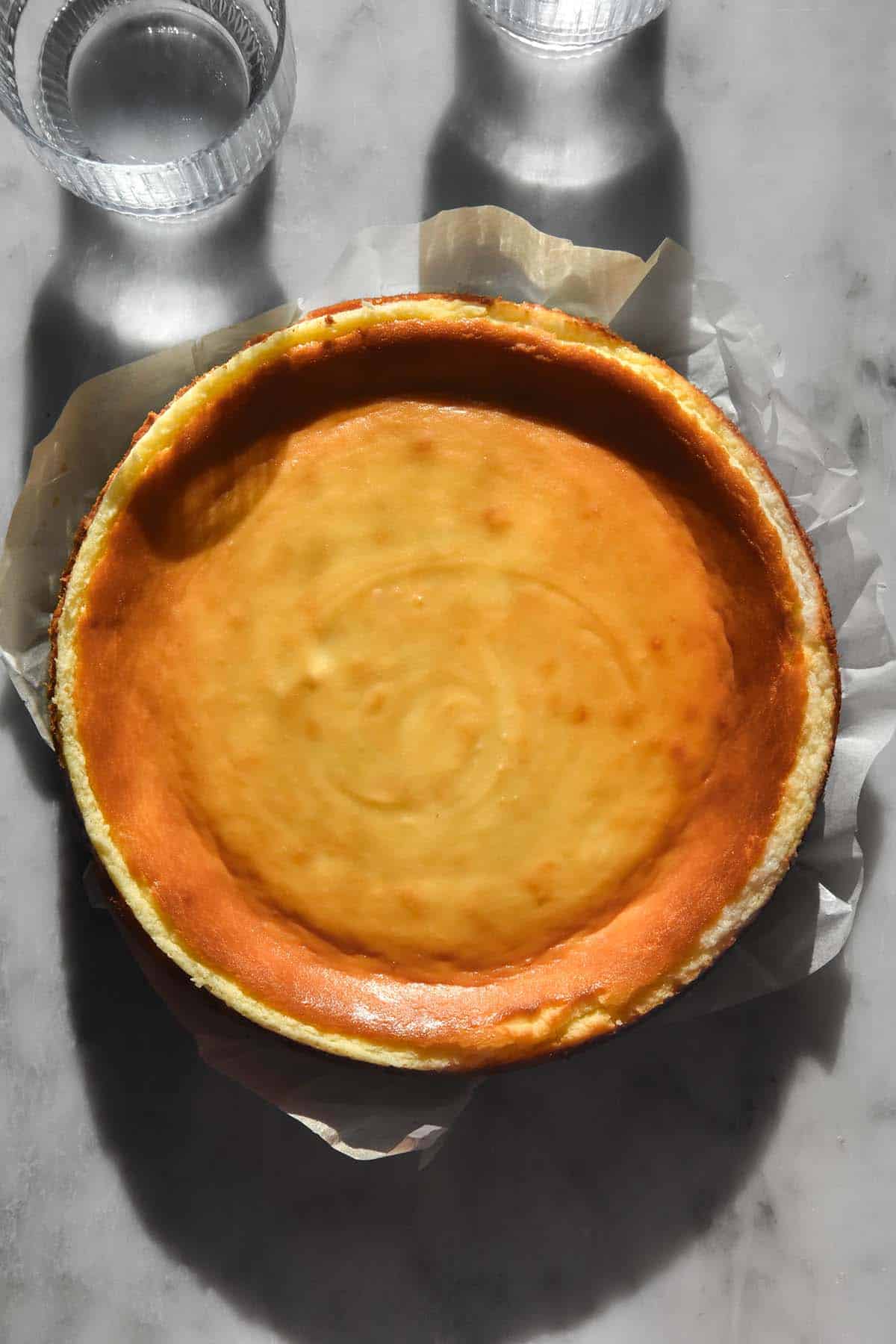
Things to keep in mind when making an eggless cheesecake
The first thing I noticed when making this cheesecake is that the edges look a little funky straight out of the oven. Perhaps unsurprisingly, it has a bit of an ‘eggless’ look. However, after the cheesecake has had time to fully cool, it should look just like any other cheesecake.
More so than any other cheesecake, I highly recommend (nay, insist) you make this cheesecake the day before. This gives the cheesecake element time to firm up and set.
The cornstarch in this cheesecake replaces the binding capacity of the eggs. I only use a small amount because I don’t want to create a pasty or floury result. Personally, I like to whisk the cornstarch into the sugar before starting to ensure it disperses evenly in the oven.
I have not tested leaving the starch out of the recipe and I don’t recommend it. We need something to hold all the dairy together and keep a creamy texture as opposed to a chalky one.
As always, it’s important to ensure the cream cheese is room temperature before you start. This will help avoid lumps of cold cream cheese in your mixture. Be sure, also, to continually scrape down the bowl with a silicon spatula to ensure there are no lumps of cream cheese on the bottom of the bowl.
Give the mixture sufficient time to incorporate on a low speed. This will help get rid of lumps but also allow the sugar to fully dissolve. This will mean less brown dots on the top of your cheesecake.
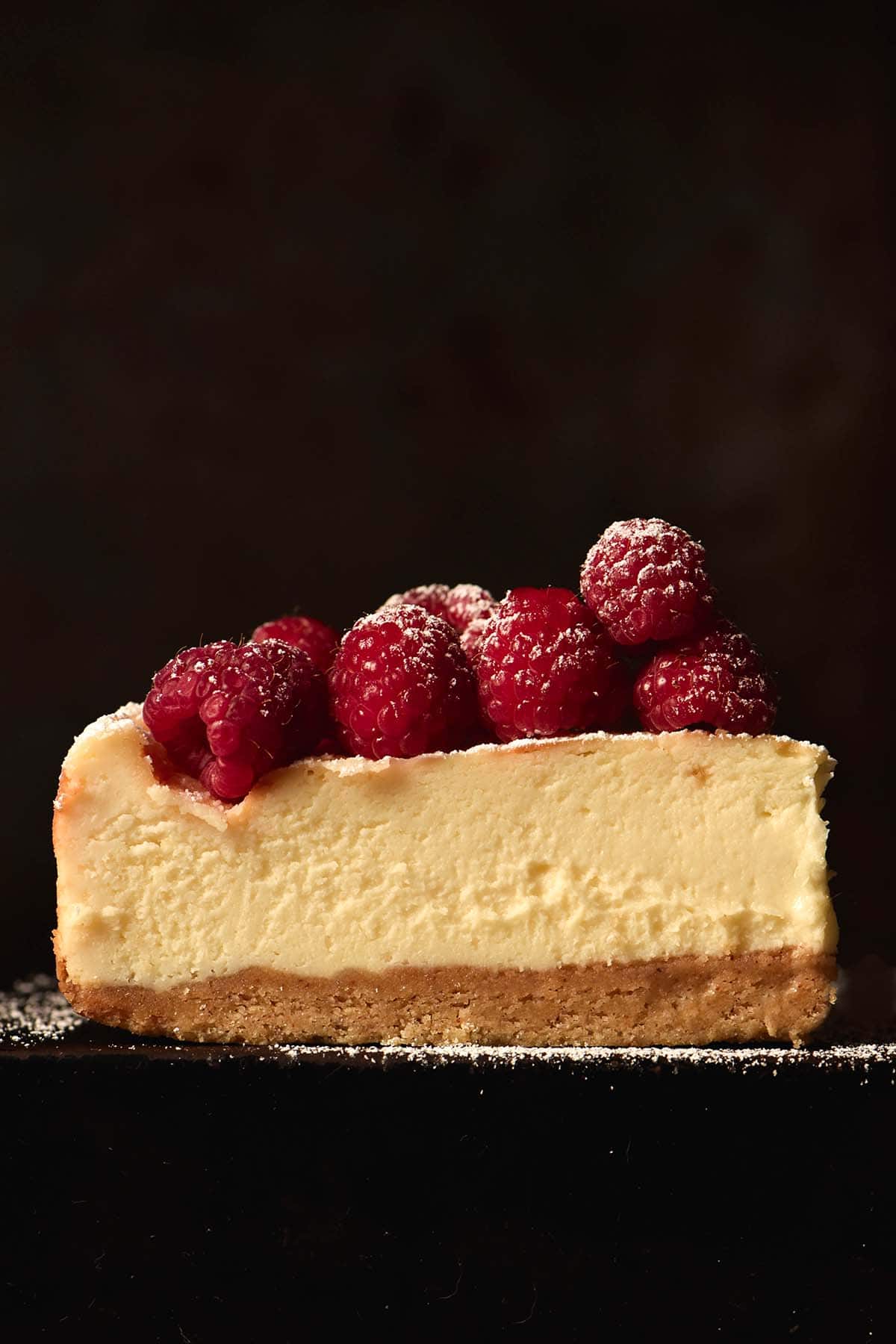
Ingredient notes for the eggless cheesecake mixture
- I recommend using Philadelphia brand cream cheese here. If you have another brand you have previously made cheesecake with and loved, you can use that too. I have previously tried to make a cheesecake with generic brand cream cheese and found the texture was really odd. I’m yet to try Aldi cream cheese so I will update the post if I do.
- Both full fat sour cream and double cream work here. I don’t recommend light cream as we are really relying on the cream component to keep the richness in the absence of eggs.
- You can use lactose free cream cheese and sour cream in place of regular varieties for a low FODMAP eggless cheesecake. I still recommend using full fat products. In Australia, we seem to only have light sour cream available at the shops. With a small amount of effort, you can make your own lactose free sour cream with my recipe. Alternatively, you can just take lactase when you eat the cheesecake – it is essentially the same thing (lactase is added to lactose free dairy products to digest the lactose ahead of time).
- I have not tested anything other than cornstarch for this recipe. Cream cheese is EXPENSIVE and I am unfortunately not from generational wealth. In time, I hope to test another starch option for those who can’t have corn. At this stage my best suggestion is tapioca starch, but I haven’t tested it myself.
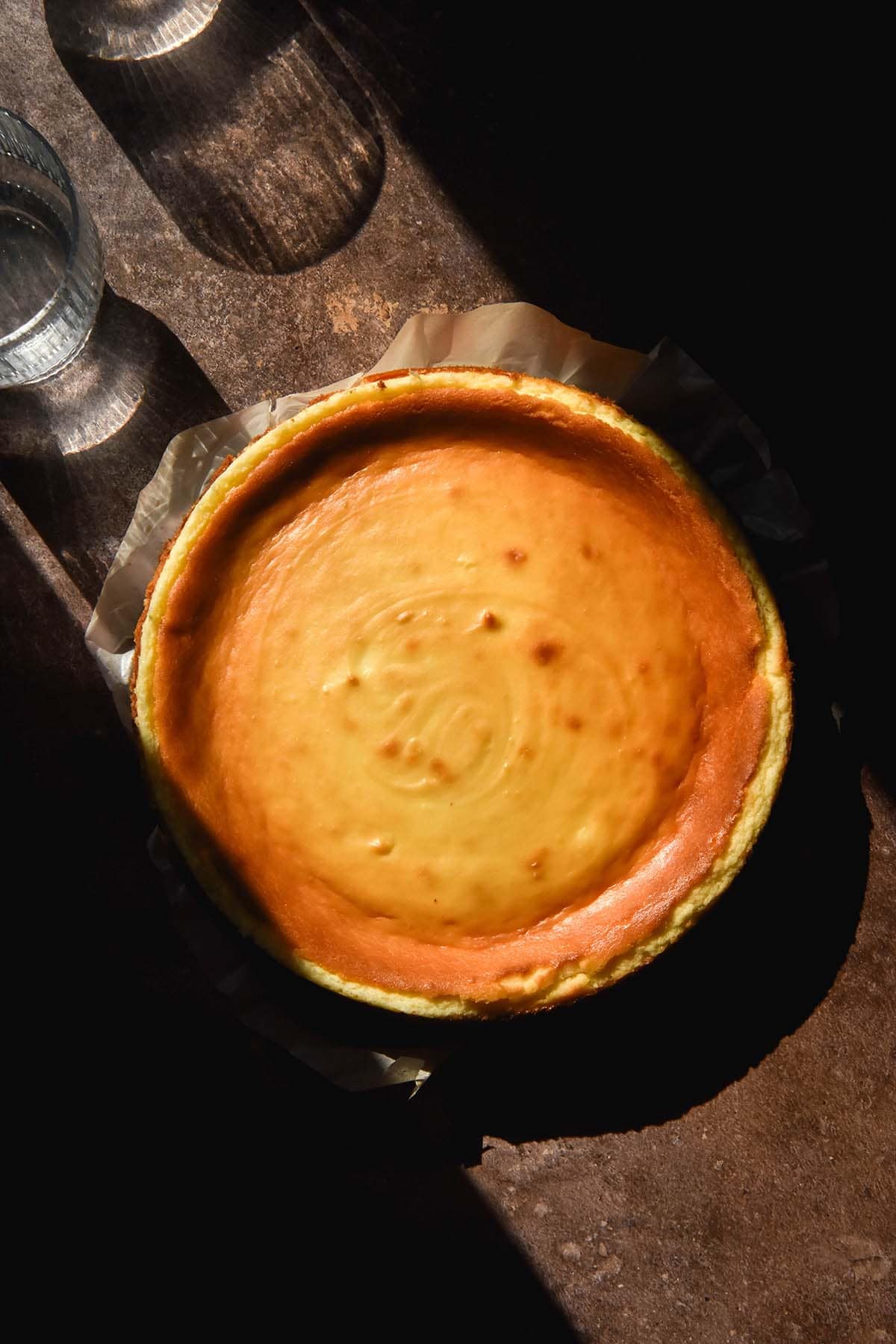
Ingredient notes for the gluten free cheesecake base
- It is worth mentioning, as you can see from the photos, that this makes a thick base. I didn’t necessarily intend for this to be the case but I absolutely love it. If you don’t, leave out the baking powder and pack the mixture down very firmly.
- You can grind your own quinoa flour from whole white quinoa. In fact, this is what I normally do. My experience is that quinoa flour from the store is rancid most of the time and has an off-putting flavour. It is much easier to use a NutriBullet or similar high powered food processor to grind the grain into flour. It takes me about 3 blending cycles in my NutriBullet, and I open the blender between each cycle so that the heat doesn’t build up and crack the plastic.
- Fresh and finely ground white rice flour is important as well. Rice flour is another one that goes rancid easily and a gritty, thick white rice flour will ruin the texture of the base. Australian friends: the brand in the box at the supermarket is not fit for baking purposes. It is far too gritty.
- I like to use salted butter for the base, but both work. I haven’t tested plant based butter because it’s a bit futile in a dairy based cheesecake.
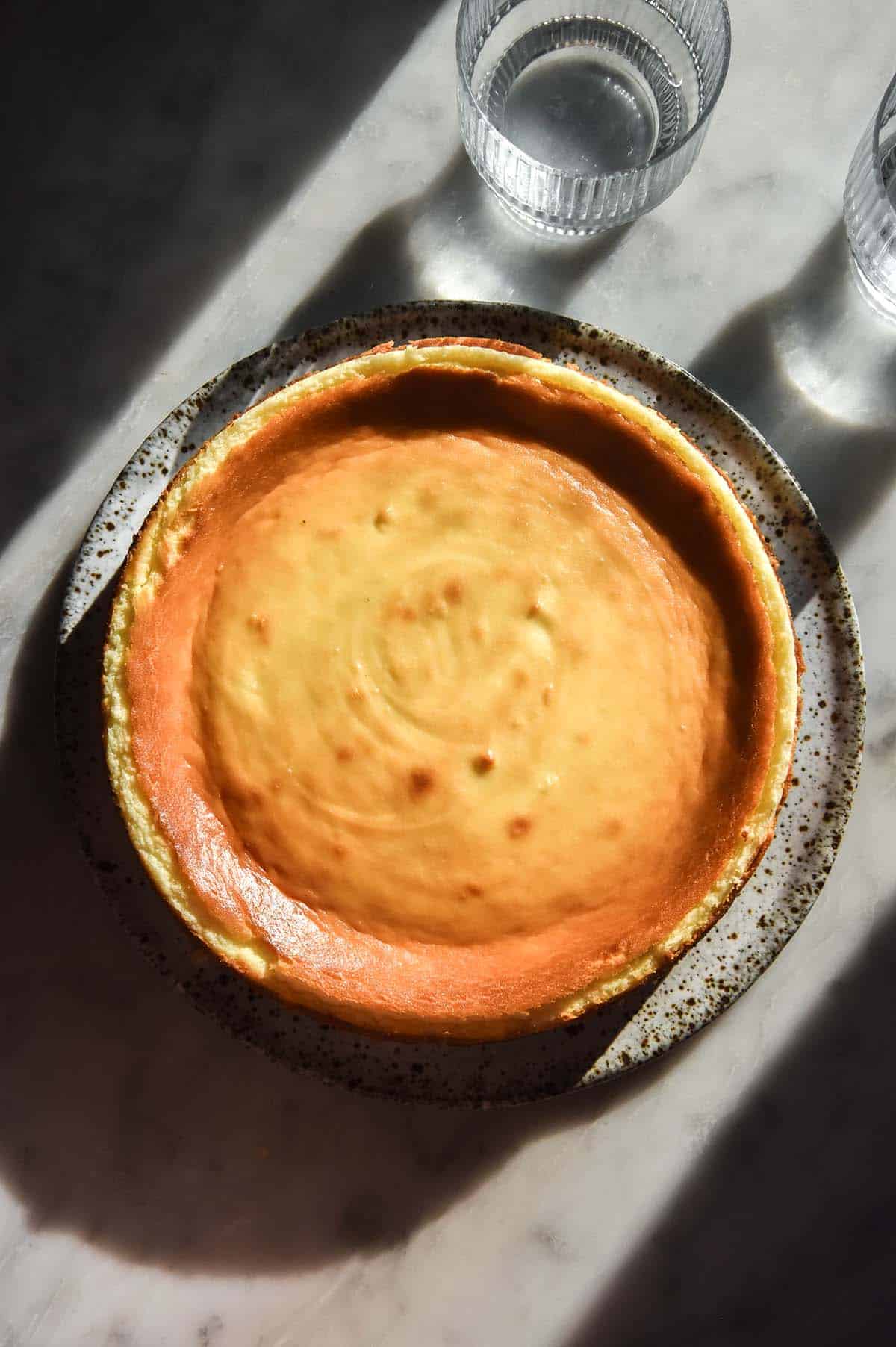
A note on cooking temperatures
Whenever I see photos of cheesecakes online, they generally always have a pale, untouched looking top. Personally, I prefer a caramelised cheesecake but perhaps I am in the minority here.
Either way, you can adjust the oven temperature based on your own preference. I baked these cheesecake tests at 180C/356F for 30-40 minutes. If you prefer a pale top and more creamy innards (I quite like a more cooked, New York style cheesecake centre), turn the oven down to 150-160C/300-320F. I would recommend baking it for anywhere from 40-60 minutes, depending on your oven and how the cheesecake is looking.
If you like a less set cheesecake, bake until the edges are firm but the centre is wobbly if you gently shake the cheesecake in the tin.
Because there are no eggs in this recipe, you are a bit more free to underbake the inside without consequence. With that said, cornstarch always needs to be cooked through to ensure it doesn’t taste pasty.
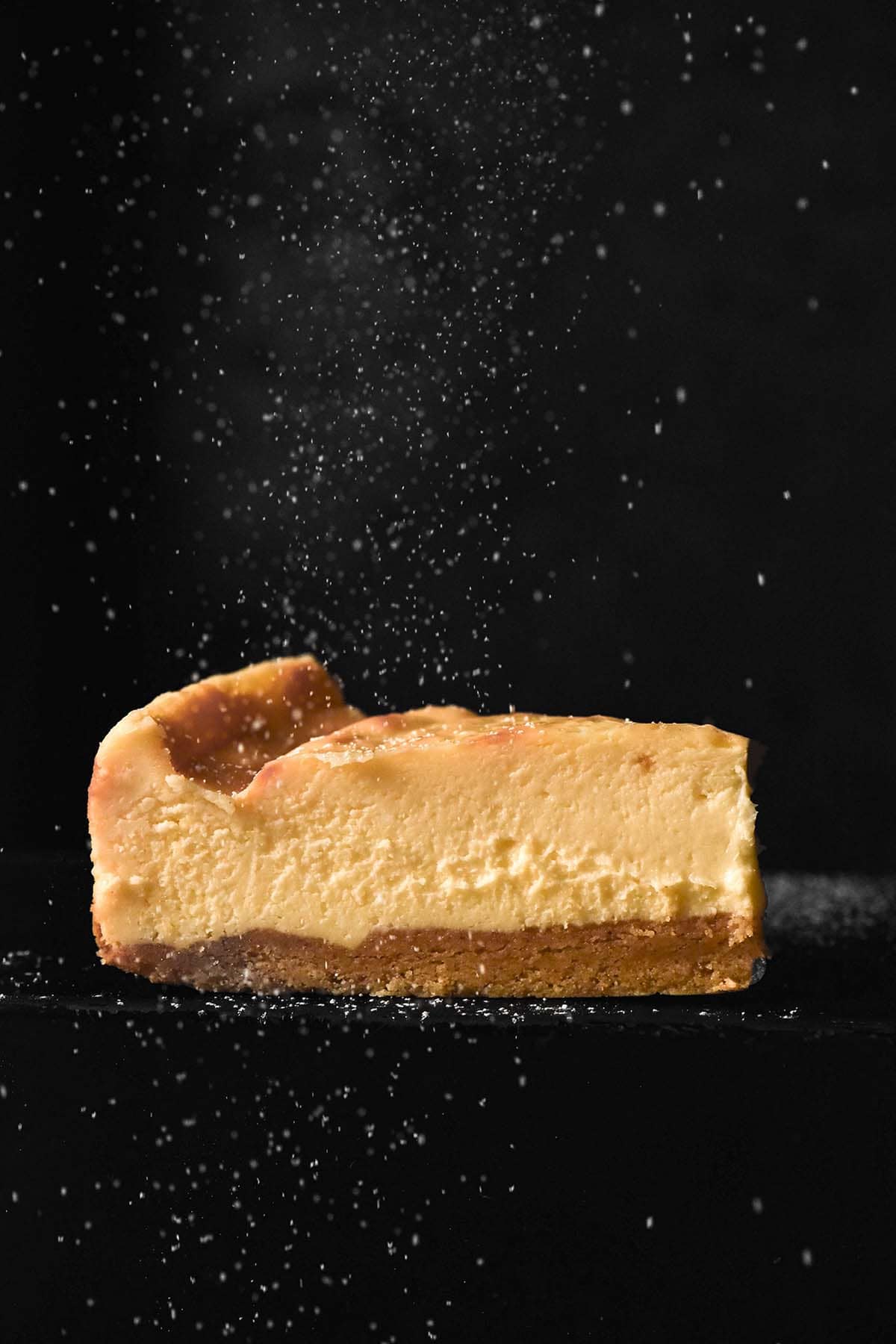
More gluten free egg free recipes
- Gluten free yeast free bread without eggs
- Gluten free vegan brownie cookies
- Gluten free banana cookies without eggs
- Gluten free cornbread without eggs
- Gluten free egg free sticky date pudding
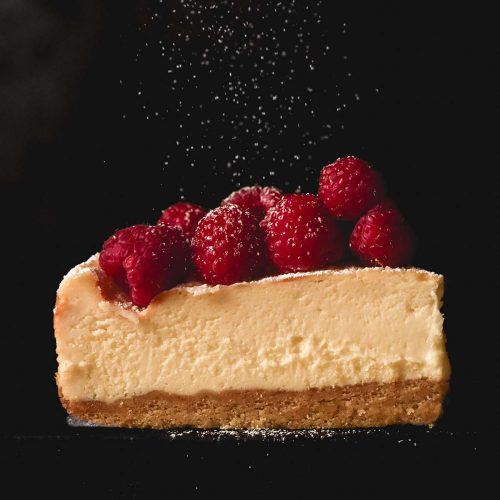
Eggless cheesecake (gluten free)
Equipment
- 24cm (9.5 inch) spring form pan
Ingredients
For the gluten free cheesecake base:
- 75 g toasted quinoa flour see notes
- 75 g fine white rice flour
- 3-5 g xanthan gum
- 1.5 g (1/4 teaspoon) baking powder (gluten free if needed)
- 100 g room temperature butter
- 100 g caster sugar/superfine sugar
- Pinch of salt
For the cheesecake:
- 1 kg good quality cream cheese room temperature (lactose free or regular)
- 300 ml/g full fat sour cream or double cream room temperature (don’t let double cream get too hot though or it might split)
- 275-300 g caster/superfine sugar
- 25 g gluten free cornstarch
- 1-2 teaspoons vanilla bean extract or paste
- 1-2 teaspoons lemon juice optional, to your tastes
Instructions
To make the gluten free cheesecake base:
- Preheat the oven to 170C/338F. Line a 24cm (9.5 inch) spring form pan – yes, the size is important. This recipe has been formulated with this size tin in mind.
- Whisk together the dry ingredients in a medium mixing bowl and set aside.
- Add the soft butter and sugar to another medium mixing bowl. Use a hand beater to cream the butter and sugar together until light in colour and fluffy looking. If you scrape a spatula through the butter, there should be no resistance and the butter should feel airy.
- Add the flour and use the beaters to just combine it. You should have a slightly sticky crumbly looking mixture.
- Press the mixture into your lined spring form pan giving even coverage. Use a fork to poke plenty of holes in the base to allow air to escape.
- Bake the cheesecake base in the oven for 15-20 minutes. It should be golden and puffy. Set aside to cool a little while you make the cream cheese component.
To make the cream cheese mixture:
- Whisk the sugar and cornstarch together in a medium bowl and set aside.
- Place the room temperature cream cheese in your stand mixer with the paddle attachment. Process it on low for a minute or so to ensure it is smooth. Scrape the bowl down and be sure to get the centre of the bowl as it tends to clump up there. Add the cream or sour cream and process until combined.
- Add the sugar cornstarch mix and allow to process for a few more minutes to ensure the sugar is dissolved. Scrape down the bowl again to ensure there are no clumps of cream cheese. Finally, add the flavourings you are using (vanilla and optional pinch of salt/lemon juice) and process to combine.
- Pour the cheesecake mixture onto the baked base. Gently bang the pan against the counter a few times to smooth out the surface and encourage any air to the top.
- Place the cheesecake on a sturdy baking sheet and into the oven. If you like a pale cheesecake, turn the oven down to 160C/320F (I baked the version in the photos at 180C/356F because I like a browned top). Bake for 40-50 minutes until puffy and cooked around the outsides but jiggly in the middle.
- When the cheesecake is cooked, turn off the oven and leave the door ajar. Allow the cheesecake to sit in the oven for 15-20 minutes like this.
- Take the cheesecake out of the oven and carefully run a knife around the edge. This will help ensure it doesn’t crack as it cools (sometimes the cracking is caused by the edge pieces being stuck to the pan).
- Allow the cheesecake to cool before transferring to the fridge. I always recommend making cheesecake the night before so it has time to properly cool and set. This results in a gorgeously soft and creamy centre that remains easy to slice.
Notes
- Toasted quinoa flour is what creates the Graham cracker like flavour here. It is not optional and can’t be substituted.
- I grind whole quite quinoa to flour in my Nutribullet and then toast it over a low heat, stirring constantly. It should be a medium brown colour and smell deliciously nutty.
- I have added xanthan gum to the base because there is already xanthan gum in store bought cream cheese. I haven’t tested it without xanthan gum, but there is a version of this recipe in Intolerance-Friendly Kitchen that is xanthan gum free.
- Make sure you don’t buy gritty or stale white rice flour or you will absolutely taste it. Australians: don’t buy the stuff in the box at the supermarket.
- If you need the cheesecake to be lactose free, I recommend using lactase drops in regular, full fat double cream. The lactose free versions of these products are often ‘light’ and don’t contribute enough richness to a good cheesecake.
- I can’t overstate how much variation in added sugar I have seen when it comes to cheesecake recipes. I’ve seen recipes with similar ingredient ratios to this one have anywhere from 250-400g sugar (and they were all well reviewed). Something to keep in mind if you like a really sweet cheesecake. I would describe this recipe as sweet but maybe not a very sweet tooth’s idea of super sweet.
- Lactose free dairy products taste sweeter than regular dairy. This is a result of the lactase enzyme converting the lactose to glucose and galactose. If you use lactose free cream cheese and cream, use a lesser amount of sugar.

No Comments